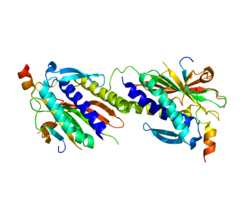
Summary
Protein reversionless 3-like (REV3L) also known as DNA polymerase zeta catalytic subunit (POLZ) is an enzyme that in humans is encoded by the REV3L gene.[5][6][7]
| REV3L | |||||||||||||||||||||||||||||||||||||||||||||||||||
|---|---|---|---|---|---|---|---|---|---|---|---|---|---|---|---|---|---|---|---|---|---|---|---|---|---|---|---|---|---|---|---|---|---|---|---|---|---|---|---|---|---|---|---|---|---|---|---|---|---|---|---|
 | |||||||||||||||||||||||||||||||||||||||||||||||||||
| |||||||||||||||||||||||||||||||||||||||||||||||||||
| Identifiers | |||||||||||||||||||||||||||||||||||||||||||||||||||
| Aliases | REV3L, POLZ, REV3, REV3 like, DNA directed polymerase zeta catalytic subunit | ||||||||||||||||||||||||||||||||||||||||||||||||||
| External IDs | OMIM: 602776 MGI: 1337131 HomoloGene: 48147 GeneCards: REV3L | ||||||||||||||||||||||||||||||||||||||||||||||||||
| |||||||||||||||||||||||||||||||||||||||||||||||||||
| |||||||||||||||||||||||||||||||||||||||||||||||||||
| |||||||||||||||||||||||||||||||||||||||||||||||||||
| |||||||||||||||||||||||||||||||||||||||||||||||||||
| |||||||||||||||||||||||||||||||||||||||||||||||||||
| Wikidata | |||||||||||||||||||||||||||||||||||||||||||||||||||
| |||||||||||||||||||||||||||||||||||||||||||||||||||
The Rev3 subunit interacts with Rev7 to form Pol ζ, a B family polymerase. Pol ζ lacks 3' to 5' exonuclease activity and is a moderate fidelity polymerase. It cannot add nucleotides across from DNA lesions, yet it can extend from primers with terminal mismatches. This makes Pol ζ very important in translesion synthesis (TLS), because it can act in concert with other TLS polymerases that can add across the lesion to complete the bypass of the lesion. Most polymerases have difficulty extending mismatches because they cannot bind properly to the mismatched DNA. So rather than the cell dying, it can survive albeit with a mutation that may or may not be deleterious, so it is believed that Pol ζ is a driving force of evolution.[citation needed]
Interactions edit
References edit
- ^ a b c GRCh38: Ensembl release 89: ENSG00000009413 – Ensembl, May 2017
- ^ a b c GRCm38: Ensembl release 89: ENSMUSG00000019841 – Ensembl, May 2017
- ^ "Human PubMed Reference:". National Center for Biotechnology Information, U.S. National Library of Medicine.
- ^ "Mouse PubMed Reference:". National Center for Biotechnology Information, U.S. National Library of Medicine.
- ^ Gibbs PE, McGregor WG, Maher VM, Nisson P, Lawrence CW (Jul 1998). "A human homolog of the Saccharomyces cerevisiae REV3 gene, which encodes the catalytic subunit of DNA polymerase zeta". Proc Natl Acad Sci U S A. 95 (12): 6876–80. Bibcode:1998PNAS...95.6876G. doi:10.1073/pnas.95.12.6876. PMC 22668. PMID 9618506.
- ^ Morelli C, Mungall AJ, Negrini M, Barbanti-Brodano G, Croce CM (Mar 1999). "Alternative splicing, genomic structure, and fine chromosome localization of REV3L". Cytogenet Cell Genet. 83 (1–2): 18–20. doi:10.1159/000015157. PMID 9925914. S2CID 45239336.
- ^ "Entrez Gene: REV3L REV3-like, catalytic subunit of DNA polymerase zeta (yeast)".
- ^ Murakumo Y, Roth T, Ishii H, Rasio D, Numata S, Croce CM, Fishel R (February 2000). "A human REV7 homolog that interacts with the polymerase zeta catalytic subunit hREV3 and the spindle assembly checkpoint protein hMAD2". J. Biol. Chem. 275 (6): 4391–7. doi:10.1074/jbc.275.6.4391. PMID 10660610.
- ^ Murakumo Y, Ogura Y, Ishii H, Numata S, Ichihara M, Croce CM, Fishel R, Takahashi M (September 2001). "Interactions in the error-prone postreplication repair proteins hREV1, hREV3, and hREV7". J. Biol. Chem. 276 (38): 35644–51. doi:10.1074/jbc.M102051200. PMID 11485998.
Further reading edit
- Xiao W, Lechler T, Chow BL, et al. (1998). "Identification, chromosomal mapping and tissue-specific expression of hREV3 encoding a putative human DNA polymerase zeta". Carcinogenesis. 19 (5): 945–9. doi:10.1093/carcin/19.5.945. PMID 9635887.
- Lin W, Wu X, Wang Z (1999). "A full-length cDNA of hREV3 is predicted to encode DNA polymerase zeta for damage-induced mutagenesis in humans". Mutat. Res. 433 (2): 89–98. doi:10.1016/s0921-8777(98)00065-2. PMID 10102035.
- Karayianni E, Magnanini C, Orphanos V, et al. (2000). "Transcriptional map of chromosome region 6q16→q21". Cytogenet. Cell Genet. 86 (3–4): 263–6. doi:10.1159/000015356. PMID 10575223. S2CID 39490958.
- Murakumo Y, Roth T, Ishii H, et al. (2000). "A human REV7 homolog that interacts with the polymerase zeta catalytic subunit hREV3 and the spindle assembly checkpoint protein hMAD2". J. Biol. Chem. 275 (6): 4391–7. doi:10.1074/jbc.275.6.4391. PMID 10660610.
- Masutani C, Kusumoto R, Iwai S, Hanaoka F (2000). "Mechanisms of accurate translesion synthesis by human DNA polymerase eta". EMBO J. 19 (12): 3100–9. doi:10.1093/emboj/19.12.3100. PMC 203367. PMID 10856253.
- Kawamura K, O-Wang J, Bahar R, et al. (2001). "The error-prone DNA polymerase zeta catalytic subunit (Rev3) gene is ubiquitously expressed in normal and malignant human tissues". Int. J. Oncol. 18 (1): 97–103. doi:10.3892/ijo.18.1.97. PMID 11115544.
- Murakumo Y, Ogura Y, Ishii H, et al. (2001). "Interactions in the error-prone postreplication repair proteins hREV1, hREV3, and hREV7". J. Biol. Chem. 276 (38): 35644–51. doi:10.1074/jbc.M102051200. PMID 11485998.
- Li Z, Zhang H, McManus TP, et al. (2003). "hREV3 is essential for error-prone translesion synthesis past UV or benzo[a]pyrene diol epoxide-induced DNA lesions in human fibroblasts". Mutat. Res. 510 (1–2): 71–80. doi:10.1016/S0027-5107(02)00253-1. PMID 12459444.
- Zhu F, Jin CX, Song T, et al. (2003). "Response of human REV3 gene to gastric cancer inducing carcinogen N-methyl-N'-nitro-N-nitrosoguanidine and its role in mutagenesis". World J. Gastroenterol. 9 (5): 888–93. doi:10.3748/wjg.v9.i5.888. PMC 4611392. PMID 12717825.
- Mungall AJ, Palmer SA, Sims SK, et al. (2003). "The DNA sequence and analysis of human chromosome 6". Nature. 425 (6960): 805–11. doi:10.1038/nature02055. PMID 14574404.
- Ohashi E, Murakumo Y, Kanjo N, et al. (2005). "Interaction of hREV1 with three human Y-family DNA polymerases". Genes Cells. 9 (6): 523–31. doi:10.1111/j.1356-9597.2004.00747.x. PMID 15189446. S2CID 24470762.
- Tao WA, Wollscheid B, O'Brien R, et al. (2005). "Quantitative phosphoproteome analysis using a dendrimer conjugation chemistry and tandem mass spectrometry". Nat. Methods. 2 (8): 591–8. doi:10.1038/nmeth776. PMID 16094384. S2CID 20475874.
- Olsen JV, Blagoev B, Gnad F, et al. (2006). "Global, in vivo, and site-specific phosphorylation dynamics in signaling networks". Cell. 127 (3): 635–48. doi:10.1016/j.cell.2006.09.026. PMID 17081983. S2CID 7827573.







